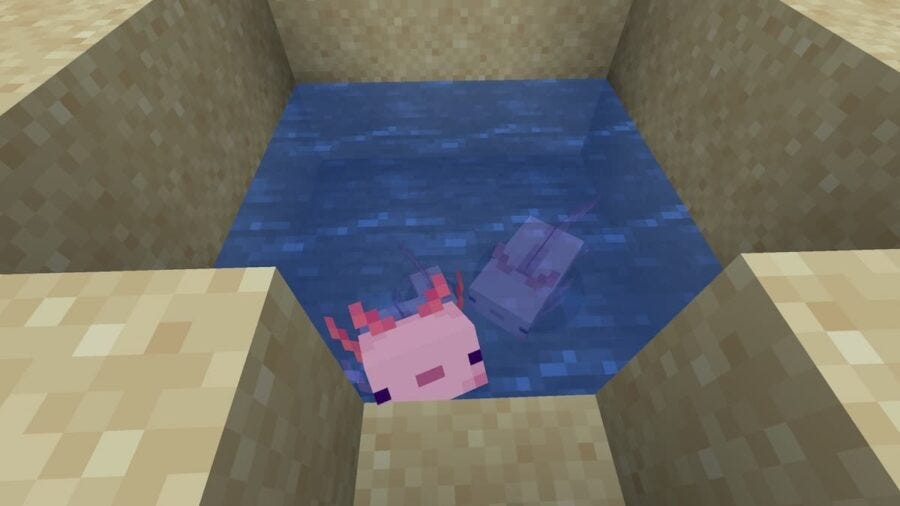With the rise in popularity of games like Minecraft, many families are finding themselves intrigued by axolotls. These unique amphibians, often dubbed “Mexican Walking Fish,” have captured the imaginations of children and adults alike. But the real question is: Are Axolotls A Good Pet for your home? Let’s dive into the reality of axolotl ownership and explore whether they are the right fit for you and your family.
Axolotls, despite their fishy nickname, are not fish at all. They are actually neotenic salamanders, meaning they retain their larval features throughout adulthood. This gives them their distinctive feathery gills and perpetually youthful appearance, which contributes to their charm and appeal, especially to those familiar with them through video games.
 A close-up shot of an axolotl in an aquarium, showcasing its distinctive external gills and pinkish skin.
A close-up shot of an axolotl in an aquarium, showcasing its distinctive external gills and pinkish skin.
The recent surge in axolotl popularity isn’t surprising, considering trends often mirror pop culture. Just as seen with huskies after Game of Thrones or Jack Russells after certain advertisements, Minecraft’s axolotl update has sparked a wave of interest. However, as New Zealand’s Chief Veterinary Officer Helen Beattie points out, trends fade, but the responsibility of pet ownership remains. Before giving in to demands for these fascinating creatures, it’s crucial to understand their needs beyond the digital realm.
One of the most important things to realize is that axolotls are not low-maintenance pets. Dr. Beattie emphasizes the long-term commitment involved, stating, “Don’t do it unless you can commit to looking after an axolotl for at least 10 to 15 years, and you can give it an enriched life for its whole life.” This isn’t a fleeting pet fad; it’s a decade-long commitment, at minimum.
Setting up an appropriate habitat for an axolotl is more involved than many expect. They require a substantial tank, at least 20 gallons, with regular cleaning due to their considerable waste production. A secure lid is also essential as they are known to jump. Water quality is paramount; specific water flow standards must be maintained, as incorrect flow can lead to stress, illness, and loss of appetite. Daily tank maintenance to remove waste is a non-negotiable aspect of axolotl care.
Furthermore, axolotls are sensitive to light and temperature. Direct lighting can stress them and overheat their tank, requiring the tank temperature to be consistently maintained between 14–18°C (57-64°F). They truly are “divas,” as Dr. Beattie aptly describes them – “slimy, gilled divas with no eyelids” that demand precise environmental conditions. It’s also worth noting that axolotls can exhibit cannibalistic tendencies if overcrowded, although they possess the remarkable ability to regenerate lost limbs.
Dr. Beattie further advises against axolotls as pets for young children. “They can be great pets, but they aren’t great pets for everyone – and children need to know that they can’t handle an axolotl as they’re very delicate and they can get injured. They also need a very quiet home with a lot of space – children aren’t known to be very quiet.” Their delicate nature and need for a tranquil environment often clashes with the energy of a typical family home.
Adding to this perspective, SPCA’s Scientific Officer Dr Alison Vaughan classifies axolotls as non-traditional pets in New Zealand and does not recommend them as companion animals. She highlights their high-maintenance nature, the hands-off approach required (avoiding handling), and their need for quiet and space, coupled with their long lifespan of 10 to 15 years. Dr. Vaughan concludes, “In most cases – no, they do not make good companion animals,” and strongly suggests that “In most cases their welfare needs cannot be met in captivity.”
The challenges of meeting an axolotl’s welfare needs in a domestic setting are significant. The SPCA routinely encounters axolotls suffering from issues like malnutrition, inadequate living conditions, lack of enrichment, and insufficient veterinary care. This underscores the complexity of caring for these exotic creatures and the potential for their needs to be overlooked or unmet by unprepared owners.
Beyond the demands of their care in captivity, it’s also essential to consider the axolotl’s wild status. Surprisingly, they are listed as critically endangered in their natural habitat in the canals of Mexico City. While keeping them as pets isn’t a direct solution to their conservation, it does present an opportunity to educate, especially children, about responsible pet ownership and the importance of wildlife conservation.
So, are axolotls good pets? While undeniably fascinating and unique, the consensus leans towards no, at least not for the average pet owner, especially those seeking a low-maintenance companion or a pet suitable for young children. Axolotls require a significant commitment of time, resources, and specialized knowledge to thrive. If you are prepared to meet their demanding needs and appreciate them for their unique aquatic lifestyle without expecting typical pet interactions, then axolotls might be a rewarding experience. However, for most, their delicate nature and specific requirements make them a challenging choice as a household pet. Before bringing an axolotl home, a thorough and realistic assessment of your ability to provide for their complex needs is absolutely essential.

